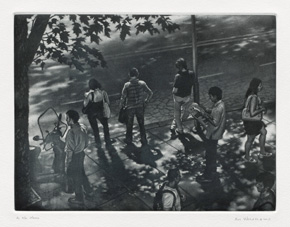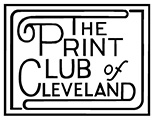Art Werger was born in Ridgewood, New Jersey in 1955. He received a Bachelor of Fine Arts from the Rhode Island School of Design in 1978 and a Master of Fine Arts degree from the University of Wisconsin in 1982. From 1982 to 2000 Werger was a Professor of Art at Wesleyan College in Macon, Georgia. Since 2000 he has been the Director of Foundations and Professor of Printmaking at Ohio University in Athens, Ohio.
Werger’s impressive, intense prints invite audiences to assume new perspectives and consider the unfolding scene as though they were casual bystanders. He encourages viewers to develop their own interpretations of the action. Werger thrives on dealing with the technical complexities of print media. He most often uses mezzotint, a type of intaglio printmaking where the artist works from dark to light. Werger carefully refines his images to reflect the precision of this process. The artists explains:
Through the media of etching and mezzotint, the images I create place the viewer in an active relationship with the subject through various forms of engagement, which are evolved from art historical, cinematic and graphic conventions. My subjects are generally depicted in a realistic manner but are often observed from unusual angles or overlaid with additional clues. These aerial vantage points, or overlapping layers of reality, create a supercharged engagement, presenting imagery in a visual equivalent of a story told by an omniscient narrator in a work of fiction.

As We Were, is a mezzotint made from a single copper plate. The image was made in the traditional manner by which a copper plate is rocked by hand. The cross hatching of a mezzotint rocker is repeated in approximately 12 different directions until the surface of the plate is completely pitted. The coarsened surface is then burnished and scraped to create any shade of grey and highlights. The process of rocking the plate took about 3 weeks, and the image work was done over a period of 7 months.
The image comes from photographic references. I took the photos directly outside of the Capuchin Crypt in Rome, Italy as I was waiting for the crypt to open to the public. I often find inspiration in images of people as they are waiting for mass transit or rushing to a meeting. It is these in-between moments that I find intriguing—moments when people are preoccupied with their destination and seem oblivious to the present time. They don’t interact with other people right next to them and lose the importance of the moment. It is during these times that I see compositions worth immortalizing, a decisive moment when the casual placement and gesture of the human form suggests a classical figurative composition.
The Crypt is a small space under the Santa Maria della Concezione dei Cappuccini in which the bones of more than 4000 Cappuchin monks have been artfully arranged to decorate the walls of the chapels. The effect is morbid and fascinating. In the very last chapel is a sign that reads, “As you are, we once were. As we are, you will someday be.” This reminder of our mortality is the source for the title of the mezzotint, As We Were.
Art Werger’s prints have received many awards and been displayed in numerous international and national exhibitions. They are included in corporate and museum collections such as the Corcoran Gallery of Art in Washington, D.C., Boston Public Library, Brooklyn Museum, Philadelphia Museum of Art, and Museum of Fine Arts in Boston. For a complete listing of collections and exhibitions see www.artwerger.com.
By Margaret Dobbins
AS WE WERE. The Print Club of Cleveland Publication No. 92, 2014. Mezzotint printed on Hannemuelle Copperplate paper by the artist at Cascade press, Athens, OH, 2012-2013.

"My recent work deals with themes of narrative storytelling by exploring the static nature of time/space in a still image and the concept of representation as shared experience."
